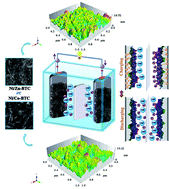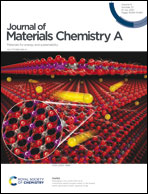Construction of highly efficient new binder-free bimetallic metal–organic framework symmetric supercapacitors: considering surface statistical and morphological analyses†
Abstract
Highly efficient new binder-free bimetallic metal–organic framework (bi-MMOF) symmetric supercapacitors were fabricated. Besides, a new and influential strategy of surface statistical and morphological studies was developed to predict the superior electrochemical performance of the bi-MMOF electrodes as energy storage materials. In this regard, a one-step, in situ, binder-free, green, and efficient process was employed for tuning the conductivity of MOFs by changing metallic cations in the inorganic nodes. New binder-free Ni/Zn-BTC and Ni/Co-BTC bi-MMOF modified electrodes were constructed and compared with the as-prepared homologues mono-metallic MOF (m-MMOF) modified electrodes. According to our studies, the simultaneous participation of two metallic cations along with the integrated, binder-free, and stable films of the designed bi-MMOF modified electrodes revealed superior and enhanced features. For more information about the textural characteristic effects of MOF modified electrodes on electrochemical (EC) performance, statistical and stereometric studies were performed on the recorded AFM data based on the Bearing Area Curve (BAC), watershed algorithm, and fractal theory. As expected, the obtained data confirmed the excellent EC performance of the bi-MMOF electrodes compared to parent m-MMOF electrodes. Among the surveyed cases, Ni/Co-BTC and Ni/Zn-BTC bi-MMOF electrodes revealed the excellent specific capacities of 263.8 and 203.3 mA h g−1 at 2.5 A g−1, suitable rate performances of 211.0 and 134.6 mA h g−1 at 20.0 A g−1, and remarkable cycle-life stabilities of 95.5 and 92.0% capacity retention up to 5000 cycles. The configured symmetric supercapacitors of Ni/Co-BTC and Ni/Zn-BTC bi-MMOF provided superior energy densities of 48.6 and 25.0 W h kg−1 at 2500 W kg−1 power density, and excellent self-stabilities of 97.6 and 92.0% up to 5000 cycles at 30.0 A g−1.



 Please wait while we load your content...
Please wait while we load your content...